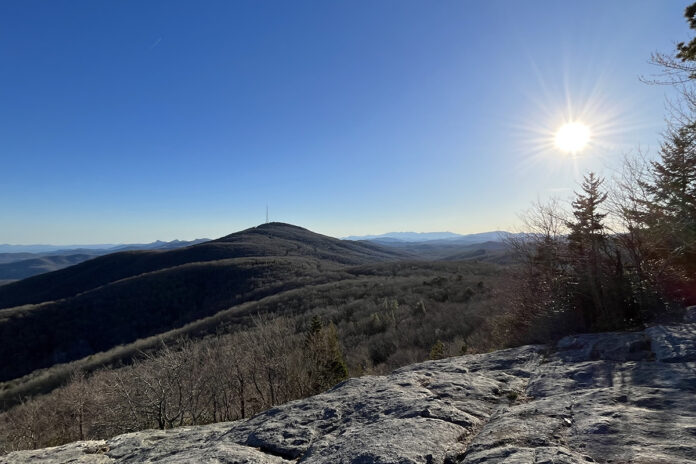
For some names of famous places, I have to wonder where the moniker came from exactly. For instance, why in the world is Devils Tower called Devils Tower? It took a little searching after the first time I saw it, but I learned it came from a Native American legend.
While traveling in western North Carolina, I did not have to wonder at all about the naming of the Blue Ridge Parkway. The name speaks for itself. It is a highway weaving along the crests of the blue hazy peaks of the Appalachian Mountains.
I can’t believe it took me a little over four decades to finally tour the Blue Ridge Parkway. I won’t soon forget the experience of hiking in the mountains along the parkway.
Six mountain chains in the Appalachians are linked along the path of the parkway. Starting in Virginia, the first 355 miles are along the Blue Ridge Mountains. Next, in North Carolina, the parkway flows through the Black Mountains, the Craggies, the Pigsahs, and the Balsams before ending at the Great Smokies.
After driving the majority of the day, my daughter and I were determined to fit in one hike before the sunset and dusk settled in on the mountains. We had our first travel hiccup of the trip and arrived too late to hike on Grandfather Mountain.
Instead, we headed to the closest entrance to the Parkway near Banner Elk and looked for a great hike. It was a Sunday evening, and we noticed a lot of cars in the parking lot near mile marker 305.
We just wanted to stretch our legs and maybe see some good views of the mountains, but overall had low expectations for our unplanned, impromptu hike.
Tanawha Trail

There were several trails to choose from offering different distances. The location was the start of the Tanawha Trail which stretches a little over 13 miles and runs parallel to the Blue Ridge Parkway.
The hike we chose, Beacon Heights, is a portion of the Tanawha Trail. In the Cherokee language, tanawha means fabulous hawk. It is an excellent name because the end of the hike offers wide-open views like those only seen by a soaring hawk.
The Beacons Heights trail is short at only .6 miles, but the trail increases in elevation by 147 feet. The steep climb through the forest is made more complex by exposed roots and rocky terrain.
Near the end of the hike, we reached a fork in the trail. We turned right and climbed the last few rocky steps. It was one of those moments when all conversation stopped suddenly when the scenery came into view.
Finally, we could see without any explanation needed why the Blue Ridge Parkway was given its name. The mountains were stacked in layers before us, building in shades of blue.
Beautiful
We were standing on a bald rock face. It was spacious with room for several different groups of hikers to rest.
The mountains before us seemed to flow together in one entity, but upon further investigation, we could identify Table Rock and Hawksbill Mountain.
Somewhere in the forest canopy, someone was playing bagpipes. I couldn’t help it, but much to the chagrin of my daughter I loudly exclaimed, “shoot, I forgot my bagpipes in the car.”
Self-deprecating humor aside, the moment was beautiful. The peak season to hike the trail is early summer. From May to July three species of rhododendrons bloom along the trail, sometimes creating a tunnel-like effect.
The hike back to the parking lot went by quickly as we focused on identifying different plants and trees. I can easily understand how the Parkway earned the nickname, “America’s Favorite Drive.”
New Deal
Construction of the Blue Ridge Parkway began in 1935 as a part of the New Deal under the presidency of Franklin D. Roosevelt. The increased availability of cars made motoring vacations a reality. Work was already underway on Skyline Drive through Shenandoah National Park.
The work of the Civil Conservation Corps in Shenandoah impressed President Roosevelt. He went on to approve the construction of a motor route connecting Shenandoah and the Great Smoky Mountains National Park.
Many details of the project were debated. One thing that was agreed upon by all parties involved was that the parkway should blend into the scenery. It would follow the crest of the southern Appalachian mountains in Virginia and North Carolina.
Our exploration of the Blue Ridge Parkway was off to a great start. There are over 120 hiking trails along the parkway. Many of them are short like Beacon Heights, allowing weary travelers a chance to stretch their legs. Other trails are long and more strenuous for experienced hikers. Our first hike was like an appetizer, just getting us ready for the main course.












